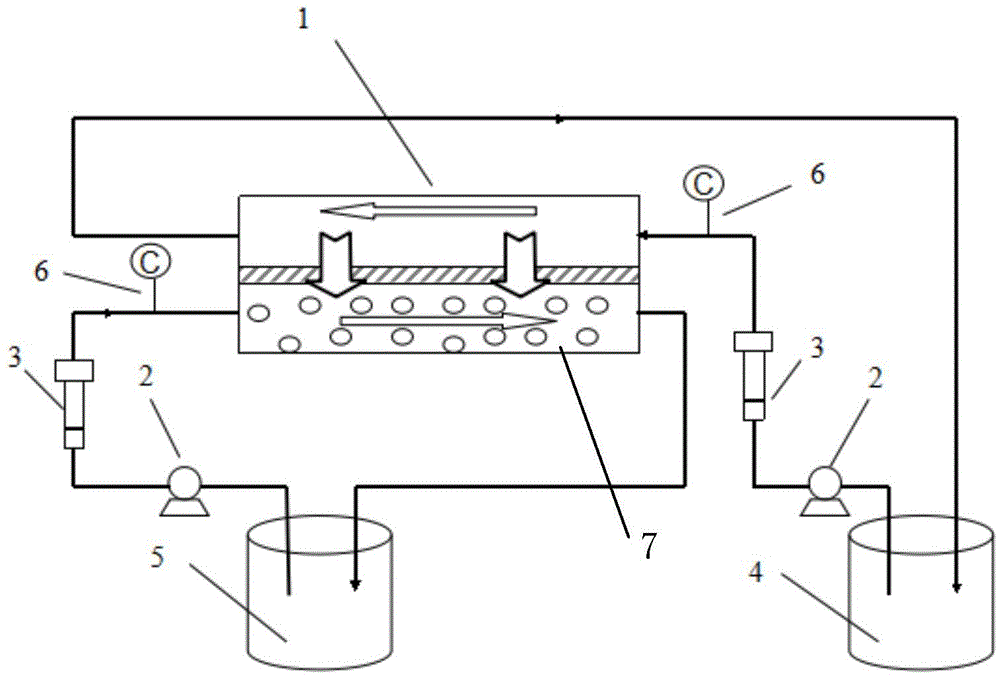Device, system and method for disposing radioactive waste water through forward osmosis
A radioactive wastewater, forward osmosis technology, applied in radioactive purification, nuclear engineering and other directions, can solve the problems of concentration polarization membrane pollution, high equipment requirements, high water pressure, etc., to achieve long replacement cycle, low energy consumption, Overcome the foaming effect
- Summary
- Abstract
- Description
- Claims
- Application Information
AI Technical Summary
Problems solved by technology
Method used
Image
Examples
Embodiment 1
[0037] In this embodiment, the device for separating cobalt in radioactive waste water by forward osmosis, such as figure 1 As shown, it includes a membrane contact chamber 1, a peristaltic pump 2, a flow meter 3, a waste water tank 4, a draw solution tank 5, and a conductivity meter 6; one side of the membrane contact chamber 1 communicates with the waste water tank 4 through a pipeline to form a circulation loop . The other side of the membrane module 1 communicates with the draw solution tank 5 through a pipeline to form a circulation loop. A peristaltic pump 2 and a flow meter 3 are connected to the two circulation loops formed on both sides of the membrane contact chamber 1 .
[0038] The experiment of separating cobalt in radioactive wastewater by using the above-mentioned device is as follows: add simulated radioactive wastewater with a cobalt ion concentration of 20mg / L into the wastewater tank, with a volume of 1L. Add a sodium chloride solution with a concentration...
Embodiment 2
[0041] In this embodiment, the device for separating cobalt in radioactive waste water by forward osmosis, such as figure 1 As shown, it includes a membrane contact chamber 1, a peristaltic pump 2, a flow meter 3, a waste water tank 4, a draw solution tank 5, and a conductivity meter 6; one side of the membrane contact chamber 1 communicates with the waste water tank 4 through a pipeline to form a circulation loop . The other side of the membrane module 1 communicates with the draw solution tank 5 through a pipeline to form a circulation loop. A peristaltic pump 2 and a flow meter 3 are connected to the two circulation loops formed on both sides of the membrane contact chamber 1 .
[0042] The experiment of separating cobalt from radioactive waste water by using the above device is as follows: add simulated radioactive waste water with cobalt ion concentration of 20mg / L to the waste water tank, and the volume of simulated radioactive waste water in the waste water circulation...
Embodiment 3
[0045] In this embodiment, the device for separating cobalt in radioactive waste water by forward osmosis, such as figure 1 As shown, it includes a membrane contact chamber 1, a peristaltic pump 2, a flow meter 3, a waste water tank 4, a draw solution tank 5, and a conductivity meter 6; one side of the membrane contact chamber 1 communicates with the waste water tank 4 through a pipeline to form a circulation loop . The other side of the membrane module 1 communicates with the draw solution tank 5 through a pipeline to form a circulation loop. A peristaltic pump 2 and a flow meter 3 are connected to the two circulation loops formed on both sides of the membrane contact chamber 1 .
[0046] The experiment of separating cobalt from radioactive waste water by using the above device is as follows: add simulated radioactive waste water with cobalt ion concentration of 20mg / L to the waste water tank, and the volume of simulated radioactive waste water in the waste water circulation...
PUM
 Login to View More
Login to View More Abstract
Description
Claims
Application Information
 Login to View More
Login to View More - R&D
- Intellectual Property
- Life Sciences
- Materials
- Tech Scout
- Unparalleled Data Quality
- Higher Quality Content
- 60% Fewer Hallucinations
Browse by: Latest US Patents, China's latest patents, Technical Efficacy Thesaurus, Application Domain, Technology Topic, Popular Technical Reports.
© 2025 PatSnap. All rights reserved.Legal|Privacy policy|Modern Slavery Act Transparency Statement|Sitemap|About US| Contact US: help@patsnap.com

